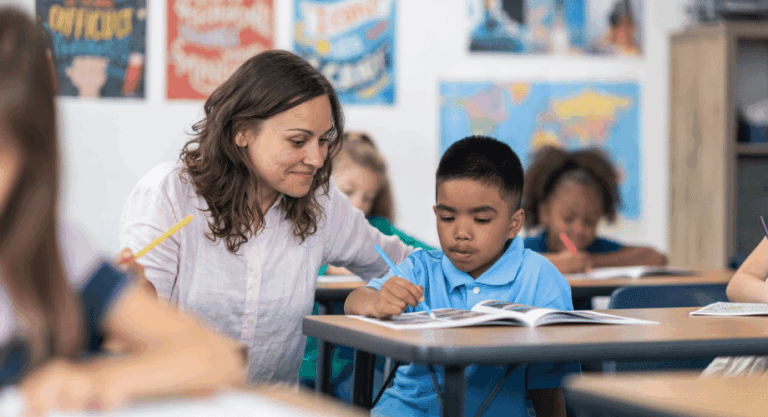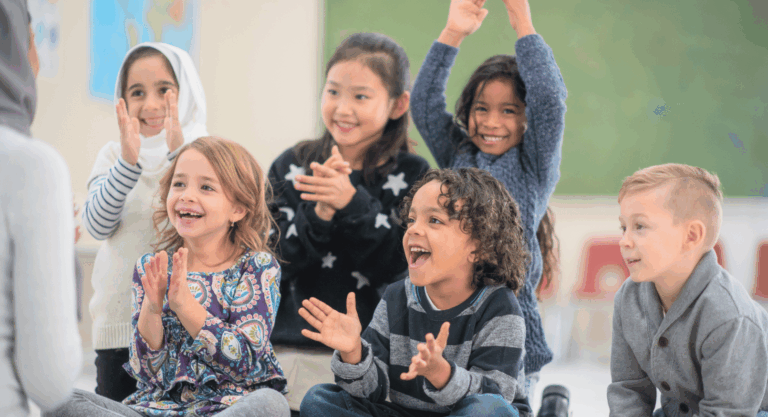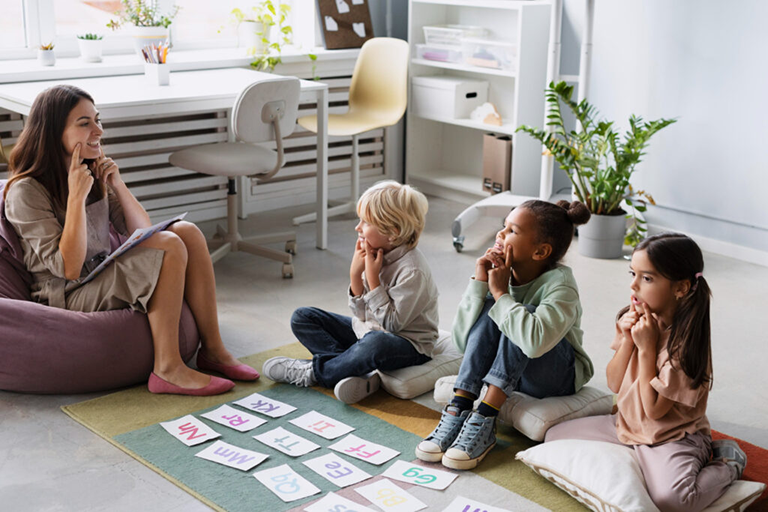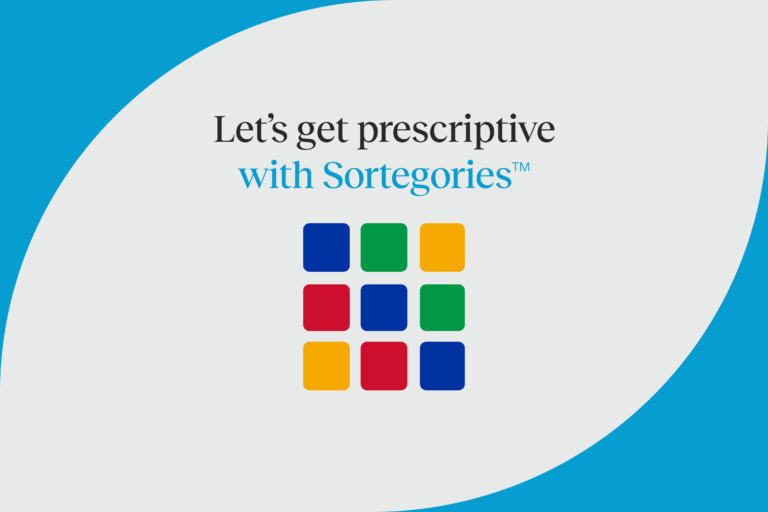How Top 10 Tools created the foundation for literacy transformation across an entire school

Erin Kaluza is an instructional coach and student performance strategist for Fargo Public Schools in North Dakota. Her school, Ed Clapp Elementary, implemented Top 10 Tools® to get their teachers, reading specialists, and other staff up to speed quickly on the science of reading. We spoke with Ms. Kaluza about how the Top 10 Tools course helped them build a foundation for the science of reading across the entire school.
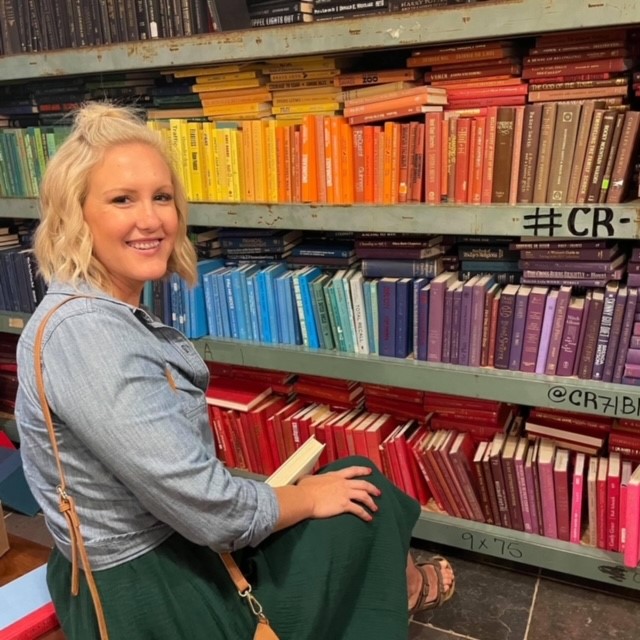
Key takeaways
- Quote: “As an instructional coach, Top 10 Tools laid a foundation across my entire school.”
- Motivation for change: Reading scores were very poor. Students weren’t learning how to read.
- Data Point: About 33% of students were falling into Tier 3 and the same in Tier 2.
- Exciting outcome: Following Top 10 Tools training and shift from balanced literacy to structured literacy school-wide, Tier 2 dropped away, and Tier 3 has dropped considerably.
How did your school choose Top 10 Tools for professional learning in the science of reading?
I’ll start with a little background. Prior to COVID, we were beginning to observe at our school level that students were missing a lot of the foundational skills for decoding and encoding and we didn’t have explicit systematic instruction in place on how to do that nor did we have resources that aligned to teach students in that way.
We wanted something comprehensive to give teachers, reading specialists, our librarian, and anyone who had touched students in the area of reading to provide them a foundation in the science of reading. We believed that Top 10 Tools and LETRS training were the two best options that we could give to our entire teacher body.
Top 10 Tools was a better fit for us initially. To start, we needed to give teachers a base knowledge as quickly as possible so that they had the why and the how. So we did that—all of our K through grade 5 elementary teachers, reading specialists, EL teachers, SPED teacher, librarian, and gifted and talented teacher took the Top 10 Tools course. We did LETRS later with the reading specialists and some of our K-2 teachers.
What were some of the outcomes of training staff with Top 10 Tools?
1. Tier 2 started to drop away.
One of the first outcomes we noticed was in the MTSS process. We have Tier 1, Tier 2, and Tier 3. Once we had Tier 1 in place, Tier 2 started to disappear. We’re still seeing this in our data. Students either get the Tier 1 instruction—it’s meeting their needs and they are proficient and on grade level, or they’re on their way to meet end-of-grade level expectations. Or they need higher repetition, more intense curriculum resources, and pacing at that Tier 3 level.
So one of the first outcomes we saw was that our Tier 2 had completely dropped away. In some classes, it’s nonexistent. In other classes, it’s two or three kids, when before, it was almost a 30%, 30%, 30% situation.
2. Teachers are using diagnostic tools and data to skillfully support students.
Another outcome we saw was in working with data. Our teachers now know how to talk about students, using decoding and encoding data that they’re observing. They look at which phonemic patterns, grapheme patterns, or encoding patterns that the students have or don’t have and they know what to do about it, what resources to pull, and then what scope and sequence to follow. Top 10 Tools follows the main decoding and encoding scope and sequences that are all around now.
Once our teachers have the ability to use diagnostic tools—a lot of these were in Top 10 Tools— they can figure out where a student is. They know how and what to do about it, and then they know the path to take to move the student through the explicit scope and sequence that we are following.
3. Tier 3 has dropped significantly.
We’ve seen an impact on Tier 3. Prior to our science of reading and Top 10 Tools training, we had a high level of Tier 3 students—about 33% of our students were falling in that Tier 3 category. Because we have that strong Tier 1 in place and we’re hitting their needs there, now in Tier 3, it’s just a matter of more repetition. Those students’ brains need more repetition back and forth to get the different grapheme and phoneme correspondences to stick.
And so it’s not a matter of what resource or what instruction they’re needing. It’s that they need more time to actually make those concrete patterns in their brain hold. And that is what our Tier 3 instruction looks like today. Because we have that firm foundation in Tier 1, it’s not something different or new for the student. They’re getting the exact same type of instruction that they’re getting in the classroom. They’re just getting a chance for more repetitions of that instruction. So they might get it again and again and again—40 times, 200 times, depending on what they need— where the Tier 1 student might hear it once or twice and have it, or under 20 times and have it. Our Tier 3 is giving those students an opportunity to hear it again and again and again and practice it again and again.
Before you did the Top 10 Tools and you had the 30% 30% 30%, what were you using?
Before we did our science of reading deep dive and identified Top 10 Tools for our initial training, we had lots of balanced literacy, and lots of Jan Richardson, author of Next Step Forward in Guided Reading. We had Fountas & Pinnell’s leveled literacy intervention (LLI). Journeys was our Tier 1 reading curriculum and there was some phonics sprinkled in, but it was more of what my principal likes to call “choose your own adventure curriculum,” where you don’t have time to implement every component of that basal reader. As a result, teachers were picking and choosing and watering down and because we didn’t know how important phonics was, that was usually the piece they were dropping off.
When it came to small group instruction, it was all leveled text—using the Jan Richardson model—not explicitly teaching anything related to sentence structure or grammar or anything like that on the writing side.
How was it shifting your school from balanced literacy to the science of reading? It sounds like your school led the district.
It wasn’t that hard for us. We actually had an external review because our district had such poor literacy scores, and so one of the things that they needed to do was have an external company come in. It was a balanced literacy company. They came into our school and did a walkthrough and gave us high marks in every single area that we were implementing.
My principal and I had a conversation about that. We were unhappy because there was something wrong. Our scores were so terrible. The kids weren’t learning how to read and now this company comes in and tells us to just keep going—you’re doing everything correctly. We couldn’t handle that. When we started having conversations with our staff, they were just as frustrated because they were working so hard and getting no results. So they were absolutely ready to try something new.
We followed up with a lot of small group conversations, debriefing sessions, and professional development time after they went through the Top 10 Tools modules. We didn’t want them to just be on their computers. We wanted to have discussions. We wanted to talk about how it was going to impact our students. A lot of the comments that we got were: “This is what we have been feeling. This is what we’ve been missing. We knew that they weren’t going to learn it through osmosis or listening to us read—they needed that explicit and systematic instruction.”
It’s so personal when you’re working with kids—you never want to say, “Oh my gosh, I’ve done something incorrectly,” because then you have to admit and face that all of those students pass through your classroom. But we’ve had a lot of conversations and we read Know Better, Do Better by David and Meredith Liben, too. It’s a really short, easy read. We did a lot of book studies at our school over the years. The Libens talk about the idea that once you know how the brain learns how to read, it’s okay to abandon some of those past practices and move on and try some other ones. You were doing the best that you could at the time. You weren’t trying to not teach a child to read. We have information now that will make it easier for us. We had some teachers who went through phases of guilt, so helping them understand they weren’t doing anything intentionally wrong, that they were doing what they were told to do, was important.
We talk a lot about how we’re trying to get “the pendulum” to stop swinging. Understanding the way the brain learns to read is refuting the pendulum. Now we know there’s no reason for it to swing anymore. Especially talking to some of the most veteran teachers in our district, they do feel like it’s a pendulum swinging and I can understand how they feel because they used to teach explicit phonics. But they didn’t have the brain research at the time. The ‘80s had a lot of good research. But it didn’t actually go inside the brain with the MRI imaging that we have now. And so it was more of the theory of the research, just like balanced literacy was at the time. Now, we’re at a spot where we can actually see inside the brain to see what’s going on when those students are learning how to read.
How have you seen the Top 10 Tools course impact your own training?
As an instructional coach, Top 10 Tools laid a foundation across my entire school. When I first started looking at aligning intervention using the science of reading rather than balanced literacy and leveled text, it made it easier for me to have conversations with teachers because they had some level of knowledge and we were all on the same playing field in understanding what we were doing. Now, when I come in and do my coaching sessions or when I’m looking at student data, I am able to support them better by looking at what their whole group lessons and small group lessons need to look like.
When we first started, we actually needed to do a whole class intervention because we were so upside down with our data. Top 10 Tools gave me the ability to have a level playing field with teacher knowledge. So I wasn’t having to go in and also give them the deep why. I was able to layer over on top of their knowledge and go deeper with them. I didn’t have to set the stage or explain everything to them in those first early sessions. They had that knowledge that I could then bounce off of and go deeper and faster with their implementation of the science of reading.
Can you talk about the 10th module of collaboration and how that contributed to your teachers?
The 10th module of collaboration added a layer to our system. We already had a PLC structure in place in our district—teachers were getting together once a week after school. So that 10th module of the Top 10 Tools with the PLC and the data conversation—we already had the structure in place. But what was nice about the 10th module is that it showed teachers a high functioning PLC talking about data related to the sites of reading.
With the 10th module, we got to be a fishbowl of watching this PLC have these conversations so we could model our language based on that. We had the structure of the time in place for teachers to have conversations. The 10th module gave everyone a chance to see what data they were looking at. It catalyzed conversations like: “Let’s look at that data too.” Or, “What do we need to watch? And what information do we need to share among our grade level so that we can monitor the decoding and encoding progress of our students?” Module 10 gave us a good model to base our conversations off.
How has the Top 10 Tools training impacted your district?
I was able to use a lot of what I learned in Top 10 Tools plus some of my other training to start advocating for some district change. At the district level I’ve had the opportunity to talk to some literacy facilitators and our curriculum directors and then other instructional coaches to start embedding a little bit more science of reading knowledge there. We’re making progress.
Don’t miss the other posts in this 3 part series:
Get to know the only science of reading course you need
Why would a large school district adopt the Top 10 Tools?
To learn more and view a demo of Top 10 Tools by 95 Percent Group™, click here.
